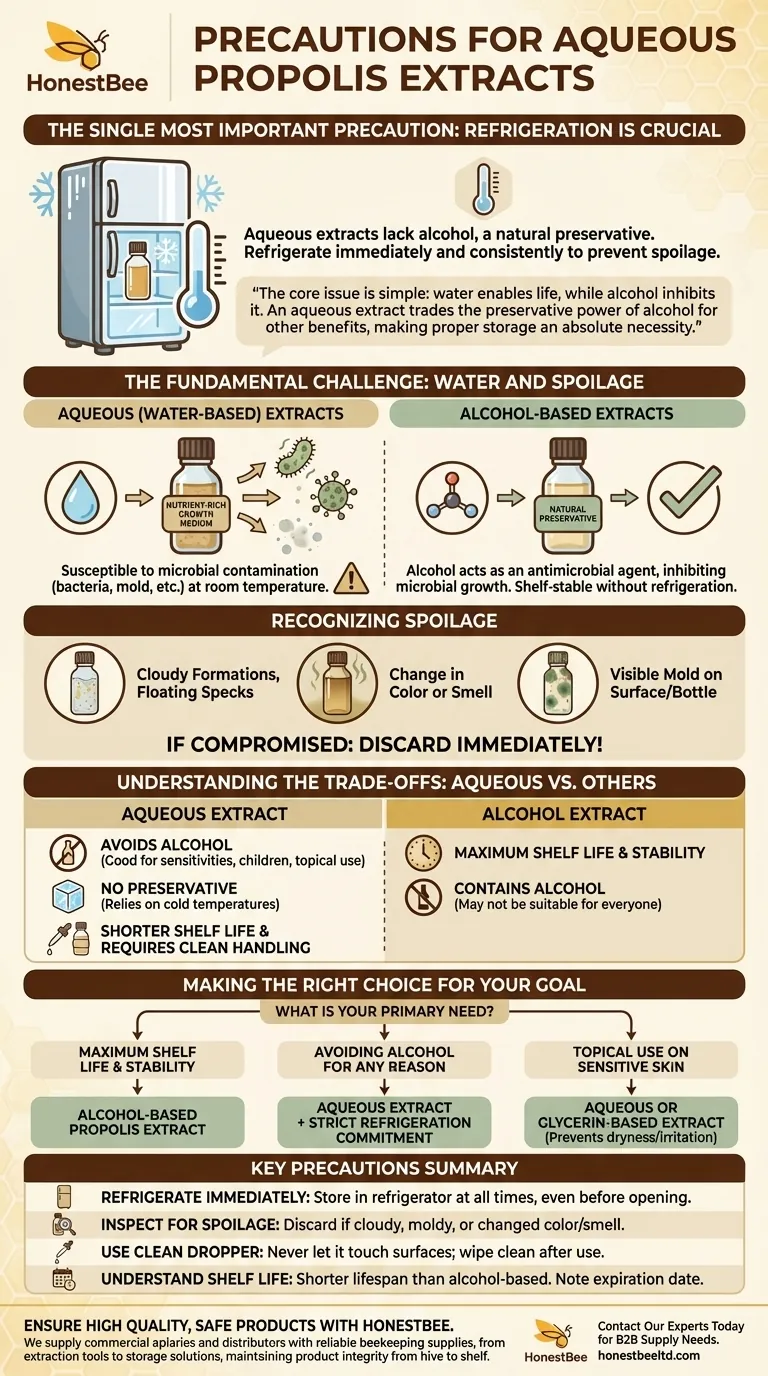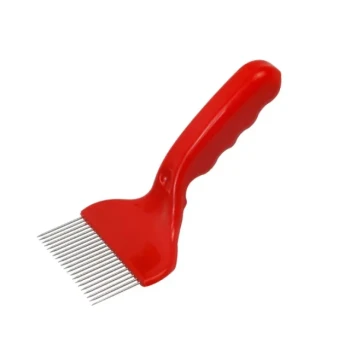The single most important precaution for aqueous propolis extracts is to keep them refrigerated. Because these extracts use water as a solvent instead of alcohol, they lack a natural preservative and are susceptible to microbial contamination, such as mold and bacterial growth, if left at room temperature.
The core issue is simple: water enables life, while alcohol inhibits it. An aqueous (water-based) propolis extract trades the preservative power of alcohol for other benefits, making proper storage an absolute necessity to ensure its safety and efficacy.

The Fundamental Challenge: Water and Spoilage
Understanding why refrigeration is critical requires understanding the difference between water-based and alcohol-based solutions. The solvent used is not just a carrier; it is the primary factor determining the product's stability.
Why Water is a Growth Medium
Water is the universal solvent for life. Its presence creates an environment where bacteria, molds, and other microbes can thrive and multiply, especially at room temperature. An aqueous propolis extract is essentially a nutrient-rich water solution, making it an ideal breeding ground if not stored correctly.
The Contrast with Alcohol Extracts
Alcohol, typically ethanol, is a potent antimicrobial agent. It acts as a natural preservative by dehydrating and denaturing the proteins of microbes, effectively killing them or inhibiting their growth. This is why alcohol-based tinctures are shelf-stable and do not require refrigeration.
Recognizing Spoilage
If an aqueous extract is compromised, you may see visible signs of spoilage. Look for cloudy formations, floating specks, a change in color or smell, or the unmistakable appearance of mold on the surface or sides of the bottle. If you observe any of these, the product should be discarded immediately.
Understanding the Trade-offs: Aqueous vs. Other Extracts
You may be using an aqueous extract for a specific reason. Acknowledging the trade-offs involved helps you handle the product correctly and appreciate its unique properties.
The Benefit of Going Alcohol-Free
The primary reason to choose an aqueous extract is to avoid alcohol. This is crucial for individuals with alcohol sensitivities, for use with children, for religious reasons, or for topical applications where alcohol can be drying or irritating to the skin.
The Preservation Downside
The trade-off for being alcohol-free is the complete loss of its preservative properties. This places the full burden of preservation on cold temperatures. Refrigeration slows down microbial metabolism and reproduction, significantly extending the product's usable life.
Shelf Life and Handling
Even with proper refrigeration, an aqueous extract will have a shorter shelf life than its alcohol-based counterpart. It's also vital to use a clean dropper for every use and to close the bottle tightly to avoid introducing external contaminants that could accelerate spoilage.
Making the Right Choice for Your Goal
To ensure safety and get the results you want, align your product choice with your primary need.
- If your primary focus is maximum shelf life and stability: Choose a traditional alcohol-based propolis extract.
- If your primary focus is avoiding alcohol for any reason: An aqueous extract is your solution, but you must commit to strict and consistent refrigeration from the moment you open it.
- If your primary focus is topical use on sensitive skin: An aqueous or glycerin-based extract is often a better choice to prevent dryness and irritation.
Ultimately, understanding your extract's composition is the key to using it safely and effectively.
Summary Table:
| Precaution | Key Reason | Action Required |
|---|---|---|
| Refrigerate Immediately | Water is a growth medium for microbes; lacks alcohol's preservative power. | Store in refrigerator at all times, even before opening. |
| Inspect for Spoilage | Product can develop mold or bacteria if compromised. | Discard if you see cloudiness, specks, mold, or a change in smell/color. |
| Use Clean Dropper | Prevents introducing external contaminants. | Never let the dropper touch surfaces or your mouth; wipe clean after use. |
| Understand Shelf Life | Shorter lifespan than alcohol-based extracts, even when refrigerated. | Note the expiration date and use within the recommended time after opening. |
Ensure your apiary or retail business offers the highest quality, safest products. HONESTBEE supplies commercial apiaries and beekeeping equipment distributors with reliable, wholesale-focused beekeeping supplies and equipment. From extraction tools to storage solutions, we help you maintain product integrity from hive to shelf. Contact our experts today to discuss your supply needs and ensure you're equipped for success.
Visual Guide

Related Products
- HONESTBEE 3-Frame Manual Acrylic Honey Extractor
- 10L Stainless Steel Honey Wax Press Extractor for Wax Cappings
- Easy Use Manual Stainless Steel Honey Press for Honey Comb
- electric honey extractor honey centrifuge 3 frame honey extractor stainless steel honey frame extractor
- HONESTBEE 6 Frame Three Use Electric Honey Extractor for Beekeeping
People Also Ask
- What is a fun and easy alternative to using a honey extractor for harvesting honey? Try the Crush and Strain Method
- How often do beekeepers collect honey? Maximize Your Hive's Sustainable Yield
- How do you manually extract honey? Choose the Best Method for Your Hive
- Which type of honey extractor is generally more durable? Focus on Material & Build Quality for Longevity
- What is the most common method for cleaning a honey extractor? Protect Your Honey & Equipment

















